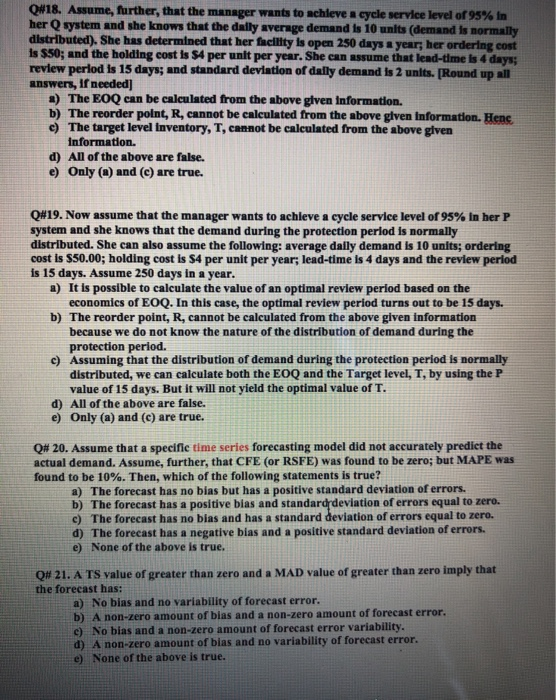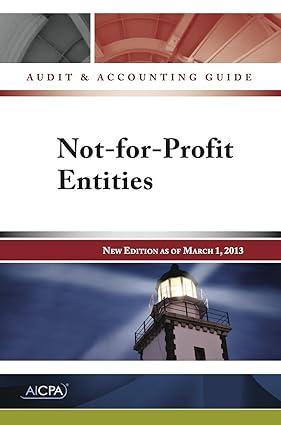Q#18. Assume, further, that the manager wants to achieve a cycle service level of 95% in her system and she knows that the daily average demand is 10 units (demand is normally distributed). She has determined that her facility is open 250 days a year; her ordering cost is $50; and the holding cost is S4 per unit per year. She can assume that lead-time is 4 days; review period is 15 days; and standard deviation of daily demand is 2 units. [Round up all answers, if needed] a) The EOQ can be calculated from the above given information. b) The reorder point, R, cannot be calculated from the above glven Information. Henc, c) The target level Inventory, T, cannot be calculated from the above given Information. d) All of the above are false. e) Only (@) and (c) are true. Q#19. Now assume that the manager wants to achieve a cycle service level of 95% in her P system and she knows that the demand during the protection period is normally distributed. She can also assume the following: average daily demand is 10 units; ordering cost is $50.00; holding cost is $4 per unit per year; lead-time is 4 days and the review period is 15 days. Assume 250 days in a year. a) It is possible to calculate the value of an optimal review period based on the economics of EOQ. In this case, the optimal review period turns out to be 15 days. b) The reorder point, R, cannot be calculated from the above given information because we do not know the nature of the distribution of demand during the protection period. c) Assuming that the distribution of demand during the protection period is normally distributed, we can calculate both the EOQ and the Target level, T, by using the P value of 15 days. But it will not yield the optimal value of T. d) All of the above are false. e) Only (a) and (c) are true. Q# 20. Assume that a specific time series forecasting model did not accurately predict the actual demand. Assume, further, that CFE (or RSFE) was found to be zero; but MAPE was found to be 10%. Then, which of the following statements is true? a) The forecast has no bias but has a positive standard deviation of errors. b) The forecast has a positive bias and standard deviation of errors equal to zero. c) The forecast has no bias and has a standard deviation of errors equal to zero. d) The forecast has a negative bias and a positive standard deviation of errors. e) None of the above is true. Q# 21. A TS value of greater than zero and a MAD value of greater than zero imply that the forecast has: a) No bias and no variability of forecast error. b) A non-zero amount of bias and a non-zero amount of forecast error. c) No bias and a non-zero amount of forecast error variability. d) A non-zero amount of bias and no variability of forecast error. e) None of the above is true. Q#18. Assume, further, that the manager wants to achieve a cycle service level of 95% in her system and she knows that the daily average demand is 10 units (demand is normally distributed). She has determined that her facility is open 250 days a year; her ordering cost is $50; and the holding cost is S4 per unit per year. She can assume that lead-time is 4 days; review period is 15 days; and standard deviation of daily demand is 2 units. [Round up all answers, if needed] a) The EOQ can be calculated from the above given information. b) The reorder point, R, cannot be calculated from the above glven Information. Henc, c) The target level Inventory, T, cannot be calculated from the above given Information. d) All of the above are false. e) Only (@) and (c) are true. Q#19. Now assume that the manager wants to achieve a cycle service level of 95% in her P system and she knows that the demand during the protection period is normally distributed. She can also assume the following: average daily demand is 10 units; ordering cost is $50.00; holding cost is $4 per unit per year; lead-time is 4 days and the review period is 15 days. Assume 250 days in a year. a) It is possible to calculate the value of an optimal review period based on the economics of EOQ. In this case, the optimal review period turns out to be 15 days. b) The reorder point, R, cannot be calculated from the above given information because we do not know the nature of the distribution of demand during the protection period. c) Assuming that the distribution of demand during the protection period is normally distributed, we can calculate both the EOQ and the Target level, T, by using the P value of 15 days. But it will not yield the optimal value of T. d) All of the above are false. e) Only (a) and (c) are true. Q# 20. Assume that a specific time series forecasting model did not accurately predict the actual demand. Assume, further, that CFE (or RSFE) was found to be zero; but MAPE was found to be 10%. Then, which of the following statements is true? a) The forecast has no bias but has a positive standard deviation of errors. b) The forecast has a positive bias and standard deviation of errors equal to zero. c) The forecast has no bias and has a standard deviation of errors equal to zero. d) The forecast has a negative bias and a positive standard deviation of errors. e) None of the above is true. Q# 21. A TS value of greater than zero and a MAD value of greater than zero imply that the forecast has: a) No bias and no variability of forecast error. b) A non-zero amount of bias and a non-zero amount of forecast error. c) No bias and a non-zero amount of forecast error variability. d) A non-zero amount of bias and no variability of forecast error. e) None of the above is true







